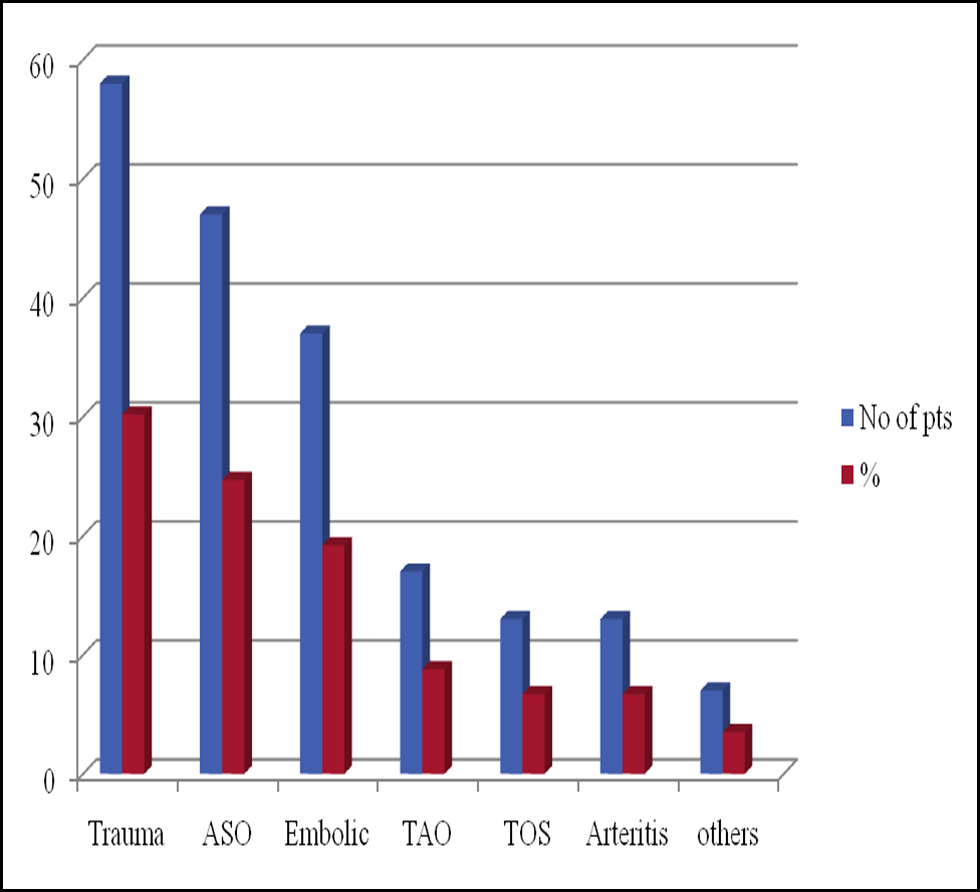
Outcome Analysis of Upper Limb Ischemia – Our Institutional Experience
Abstract
Introduction: Upper limb ischaemia (ULI) is a relatively uncommon, but well recognized vascular condition. It includes between 15-18% of the procedures that have been done for critical limb ischemia. This research study was aimed at developing not only a comprehensive but also a broad overview of ULI, specific to the population we serve.
Aim: The objective of this study was to review the experience of upper limb ischemia, both acute and chronic, of a single centre, the Institute of Vascular Surgery, Madras medical college, with particular emphasis on the pattern and distribution of the disease, their pathological profile, and reporting their outcomes with comparison to the literature on this topic.
Methods: Retrospective descriptive analysis. All patients who were admitted with symptoms and signs of upper limb ischemia were identified between august 2012 and august 2015 were included in the audit. Data were collected from the patients’ case notes and hospital registries. Upon collection of the data, the findings were analysed and compared to the recent literature on this topic.
Results: A total of 192 patients were included in the study. Of which 111 patients underwent revascularization procedures. The most common etiology for acute upper limb ischemia was traumatic injury (n=58) followed by thromboembolic disease (n=37) and that for chronic limb ischemia was atherosclerosis (n=47) followed by thromboangiitis obliterans (n=17). The mean age of distribution is 41.1 years. The extent of neurological damage could not be elicited for all the patients with traumatic injuryand conclusive data on the functional status of the salvaged limb were lacking. All patients who underwent embolectomy had a fasciotomy done routinely as part of the institutional protocol for thromboembolic disease. No mortality occurred in this group. Most of the patients with atherosclerotic occlusion and TAO were managed conservatively. All patients with TOS had their limb salvaged.
Conclusion: Upper limb ischemia though relatively uncommon, has a major impact on the functional status of the patients. Although firm conclusions cannot be drawn, it is anticipated that our institutional data will provide clinical awareness and facilitate comparison of similar experiences in different institutes enabling pooled data analysis. This may further define the various patterns of upper limb arterial disease and improve the outcome, perhaps by identifying other confounders.
Full Text:
PDFReferences
Deguara J, Ali T, Modarai B, Burnand KG. Upper limb
ischemia: 20 year experience from a single center. Vascular.
0 0 5 M a r - A p r ; 1 3 ( 2 ) : 8 4 - 9 1 .
Quraishy MS, Cawthorn SJ, Giddings AE. Critical ischaemia
of the upper limb. J R Soc Med 1992;85:269-73
Hammond DC, Gould JS, Hanel DP. Management of acute
and chronic vascular injuries to the arm and forearm.
Indications and technique. Hand Clin 1992;8:453-63
Fujitani RM, Mills JL. Acute and chronic upper extremity
ischaemia: Large vessel arterial occlusive disease. Ann
Vasc Surg 1993;7:106-12
Pentti J, Salenius JP, Kuukasjärvi P, Tarkka M. Outcome of
surgical treatment in acute upper limb ischaemia. Ann
Chir Gynaecol. 1995;84(1):25-8.
Eyers P, Earnshaw JJ. Acute non-traumatic arm
ischaemia. Br J Surg 1998;85:1340-6.
Hammond DC, Gould JS, Hanel DP. Management of acute
and chronic vascular injuries to the arm and forearm.
Indications and technique. Hand Clin 1992;8:453-63.
Sultan S, Evoy D, Eldin AS, et al. Atraumatic acute upper limb
ischemia: a series of 64 patients in a Middle East tertiary
vascular center and literature review. Vasc Surg 2001;
:181-97.
Casey RG1, Richards S, O'Donohoe M, Vascular surgery of
the upper limb: the first year of a new vascular service, Irish
Medical Journal, 2002 Apr;95(4):104-5
Stonebridge PA, Clason AE, Duncan AJ. Acute ischemia of
the upper limb compared with acute lower limb ischemia;
-yr review. British Journal of Surgery, 76:515-516 1989
Galbraith K, Collin J., Morris PJ. Recent experience with
arterial embolism of the limbs in vascular unit, Annals of
Royal College of Surgeons England, 67:30-33 1985
Hernandez-Richter T, Angele MK, Helmberger T,
Jauch KW, Lauterjung L, and Schildberg FW. Acute
ischemia of the upper extremity: long term results
following thromboembolectomy with the Fogarty
catheter. Langenbecks Arch Surg. 386:261-266
Licht PB, Balezantis T, Wolff B, Baudier JF, Roder
O C . L o n g -t e r m o u t c o m e f o l l o w i n g
thromboembolectomy in the upper extremity,
European Journal of Vascular Endovascular
Surgery. 2004 Nov; 28(5):508-12
Franz, R.W., Goodwin, R.B., Hartman, J.F., Wright,
M.L, Management of upper extremity arterial
injuries at an urban level I trauma center. Annals of
Vascular Surgery. 23:8-16 2009
Ballard JL, Bunt TJ, Malone JM, Management of
small artery vascular trauma. American Journal of
Surgery, 164:316-319 1992
Barros D'Sa AA. A decade of missile-induced
vascular trauma, Annals of Royal College of
Surgeons of England 1982;64:37-44
Spinelli F, Benedetto F, Passari G, La Spada M,
Carella G, Stilo F, De Caridi G, Lentini S. Bypass
surgery for the treatment of upper limb chronic
ischaemia. European Journal Of Vascular and
Endovascular Surgery. 2010 Feb;39(2):165-70
Criado, Mamon Berguer, Lazar Greenfield, The
spectrum of arterial compression at the thoracic
outlet. Journal of Vascular Surgery. 52:406-411
Gelabert, Machleder, Diagnosis and management
of arterial compression at the thoracic outlet. Annals
of Vascular Surgery. 11:359-366 1997
J. L. Mills, L. M. Taylor Jr, J. M. Porter, Buerger’s
disease(TAO): Annals of Vascular Surgery.
:570-572, 1992
S. Sasaki, M. Sakuma, T. Kunihara, and K. Yasuda,
Distribution of arterial involvement in
thromboangiitis obliterans (Buerger's disease):
Results of a study conducted by the intractable
vasculitis syndromes research group in Japan,
Surgery Today, vol. 30, no. 7, pp. 600–605, 2000.
Olin JW1, Shih A. Thromboangiitis obliterans
(Buerger's disease), Current Opinion in
Rheumatology. 2006 Jan;18(1):18-24
Refbacks
- There are currently no refbacks.

This work is licensed under a Creative Commons Attribution-NoDerivatives 4.0 International License.
An Initiative of The Tamil Nadu Dr MGR Medical University
 University Journal of Surgery and Surgical Specialities
University Journal of Surgery and Surgical Specialities